Sikalidis C. (ed.) Advances in Ceramics - Synthesis and Characterization, Processing and Specific Applications
Подождите немного. Документ загружается.

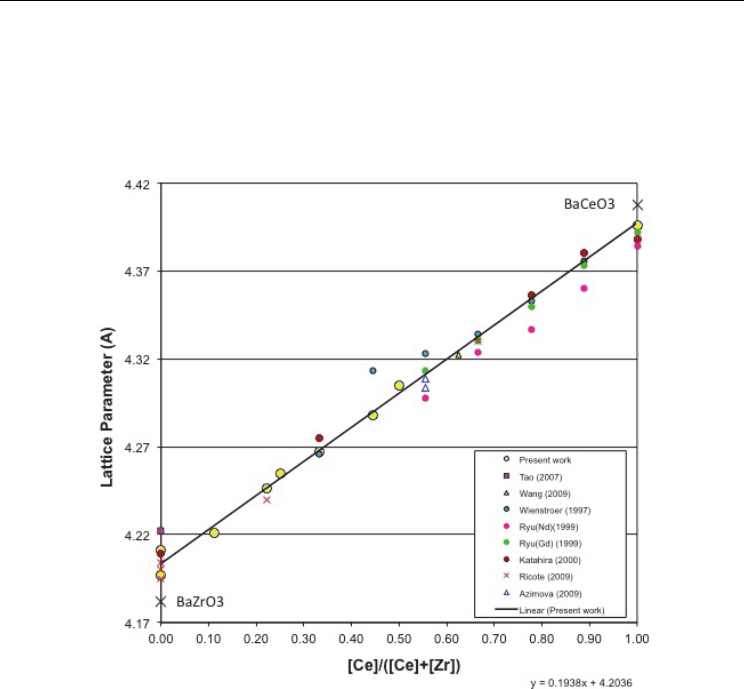
Co-Ionic Conduction in Protonic Ceramics of the
Solid Solution,BaCe
(x)
Zr
(y-x)
Y
(1-y)
O
3-
Part I: Fabrication and Microstructure
489
difference resulting from zirconium and cerium, alone. Also plotted are several published
values from the literature. The striking feature is that all barium cerate-zirconate solid
solutions exhibit almost the same linear behavior, independent of dopant type, dopant
concentration or sintering additive used. The slopes are about the same in all cases, and only
BCZNd (Ryu & Haile, 1999) exhibits a slightly smaller overall lattice constant than all the
specimens doped with gadolinium or yttrium.
Fig. 5. Pseudocubic lattice parameters vs. the ratio of occupied B-sites Ce
+4
/(Ce
+4
+Zr
+4
). The
slopes are invariant to dopant, dopant concentration or MOx sintering additive.
5.2 As-fired NiRS-BCZY26 microstructure
For the further study, the compositions
n/m = 1/3 (BCZY26) and 2/7 (BCZY27) were
selected. These specimens were prepared from extruded tubes 6mm OD x 4.5mm ID. A SEM
image of an as-fired NiRS-BCZY26 polished and thermally etched at 1425 ºC for 35 minutes
is shown if Figure 6. The ceramic is well-sintered with average grain size of 2 to 5 microns.
Figure 7 shows a micrograph of an attempt to reactive sinter BCZY without NiO addition.
The precursor powders have barely reacted at all and practically no sintering has taken
place. This underscores the dramatic effect brought about by a small addition of NiO.
A specimen prepared by focused ion beam (FIB) etching and removal from a bulk ceramic is
shown in bright field TEM in Figure 8. It is clear by the 120º dihedral angles at triple points
and absence of pores that sintering is complete. The investigation concluded that most of the
grain boundaries were clean, but evidence of some amorphous grain boundaries was
observed. A high resolution TEM is shown in Figure 9 showing a clean grain boundary
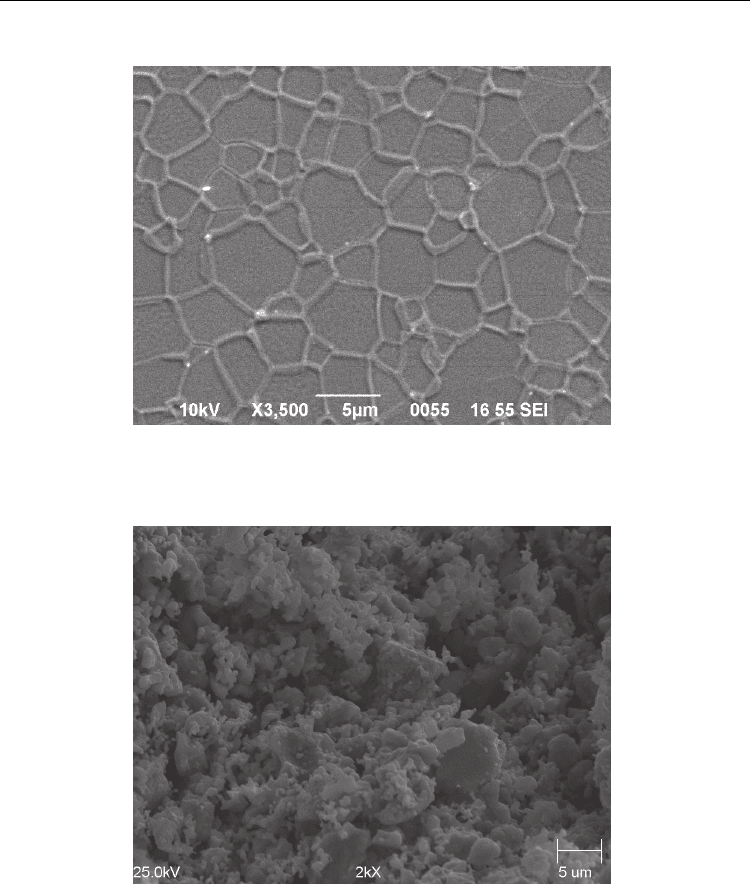
Advances in Ceramics - Synthesis and Characterization, Processing and Specific Applications
490
Fig. 6. As-fired polished and thermally etched (1425 ºC, 35 min.) surface of 1wt% NiO-
reactive sintered BCZY26 (3500x).
Fig. 7. Micrograph of attempt to reactive sintered BCZY26 without NiO addition (2000x).
intersecting with two amorphous ones at a triple point. This is obviously a significant
finding, since high grain boundary impedance has long been suspected as the reason why
the proton conductivity of doped barium zirconate is lower than expected. If a continuous
network of amorphous grain boundaries were to form during sintering, these could well be
blocking to proton transport on a macroscopic scale. The nature and extent of these
amorphous grain boundaries is currently receiving a great deal of attention.
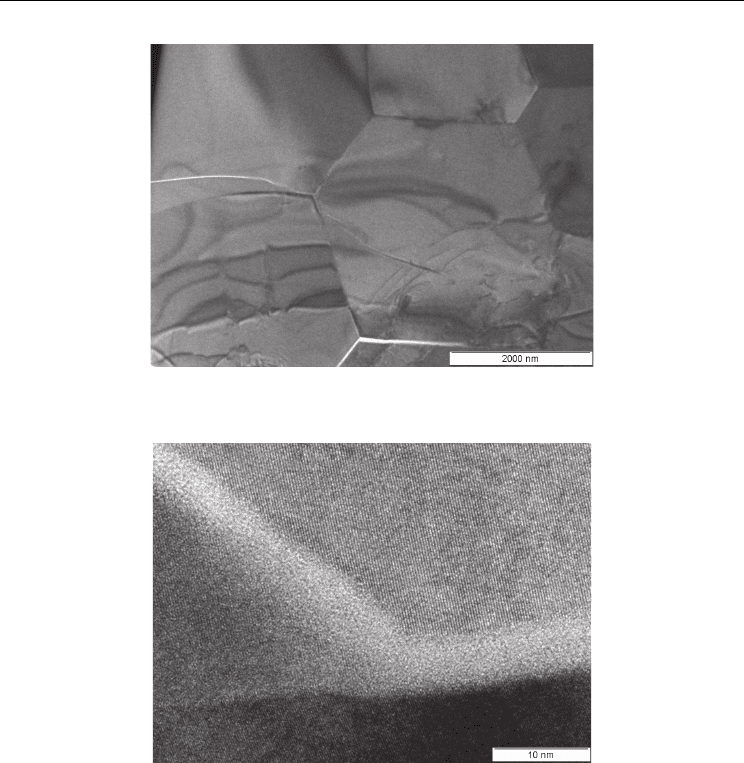
Co-Ionic Conduction in Protonic Ceramics of the
Solid Solution,BaCe
(x)
Zr
(y-x)
Y
(1-y)
O
3-
Part I: Fabrication and Microstructure
491
Fig. 8. Bright field TEM of reactive sintered BCZY26. The fracture at lower grain boundaries
is the result of mechanical sectioning of specimen.
Fig. 9. HR TEM of reactive sintered BCZY26. The image shows that some of the grain
boundaries are amorphous .
5.3 Solid state reactive sintering
Pure barium zirconate BaZrO
3
and barium cerate BaCeO
3
powders are relatively easy to
fabricate by solid state reaction, but the incorporation of the large, aliovalent yttrium ions
into the lattice is necessary in order to create the oxygen vacancies required for ion
transport. In earlier experiments at CoorsTek in Golden, attempts to synthesize phase-pure
BZY10 (10 mol% yttria-doped barium zirconate (BaZr
0.9
Y
0.1
O
3-d
)) by solid-state reaction of
ZrO
2
, Y
2
O
3
and BaCO
3
powders were not successful at temperatures as low as 1550 ºC. Only
recently was it discovered that very phase-pure BZY10 (BCZY09) calcine powder could be
produced with the addition of a small amount of NiO. This was suggested by the analogy to
the experience gained in fabricating NiO reactive sintered yttria stabilized zirconia

Advances in Ceramics - Synthesis and Characterization, Processing and Specific Applications
492
(NiYRSZ) (Swartzlander & Coors, 2009). However, when binders were added and the pre-
calcined powder was compacted and sintered at 1550 ºC, the resulting ceramic specimens
were porous, with a fired density of only 60-70%. Subsequent experiments demonstrated
that dense BZY10 could be fabricated by eliminating the traditional calcining step
altogether. By mixing and compacting just the precursor powders of zirconia, yttria, barium
carbonate, and a small amount of NiO, dense, phase-pure BZY10 could be fabricated with
relative ease at only 1550 ºC. This has become the process we refer to as NiO reactive
sintered BCZY. A variant process was attempted to make BZY10 from pre-calcined 10 mol%
yttria-stabilized zirconia (Tosoh 10YS), barium carbonate plus some NiO, but this led to
sintering difficulties and considerable residual YSZ phase in the resulting ceramic.
Apparently it is necessary to simultaneously create the cubic barium zirconate phase,
incorporate the yttria dopant, and obtain the well-sintered grain boundaries during
sintering in order to fabricate this ceramic. Ironically, this simple process uses very
inexpensive raw materials, costing no more than about $5-10 per kilogram, and readily
accessible air-fire sintering temperatures, making the commercialization of this important
material very straightforward.
Clearly, reactive sintering involves several complicated steps. We hypothesize the following:
Upon decomposition of BaCO
3
, the reaction of BaO and NiO, beginning about 1100 ºC,
produces a liquid phase that enhances the transport along grain boundaries of all the cations
involved in the solid state reactions. As temperature increases, BaCe
x
Zr
(1-x)
O
3
begins to form,
making the BaO-NiO melt increasingly nickel oxide rich and raising the melting
temperature. Initially, BaCe
x
Zr
(1-x)
O
3
has only a small concentration of intrinsic oxygen
vacancies. Incorporation of some percentage of aliovalent dopants on B-sites lowers the
Gibbs free energy, but without oxygen vacancies, diffusion by relatively large acceptor
dopant ions like yttrium is difficult. In the case of BCZY, the yttrium ions must substitute on
B-sites in the perovskite lattice by first diffusing into the zirconia or ceria grains. Since small
cations, such as Ni
2+
(0.69Å), are much more facile than Y
3+
(0.92Å), the defect reaction
initially takes place with the smaller, Ni
2+
dopant ions, which can easily diffuse into the
grain by substituting on B-sites. However, diffusion of Ni
2+
into the grain requires extra
charge compensation by creating oxygen vacancies on the anion sublattice (although more
complex defect reactions involving electron holes are certainly possible). As the
concentration of oxygen vacancies increases, diffusion of the larger Y
3+
ion is facilitated by
the vacancy transport mechanism. The nickel ions are too small to stabilize the perovskite
structure by occupying the space of a B-site Ce
4+
(0.94Å) or Zr
4+
(0.79Å) and the requirement
for charge compensation too great. The perovskite structure is more stable with the closer
matched yttrium than nickel on B-sites, so nickel ions will ultimately be displaced by
yttrium above a certain threshold concentration. This ion exchange mechanism occurs
simultaneously throughout the entire body matrix promoting phase equilibria within grains
and at grain boundaries during sintering. Ultimately, as the equilibrium BCZY phase forms,
the nickel ions are exsolved and precipitated once again at grain boundaries as NiO or
BaY
2
NiO
5
. The reason that reactive sintering does not work with pre-calcined YSZ powder
is because it is already a stable phase that has no tendency to convert from the flourite phase
to the perovskite phase at the low reactive sintering temperature, and nickel ions have no
role to play in the required solid state ion exchange reactions. Similarly, precalcined BCZY
powder does not densify even when NiO is added, which demonstrates that reactive
sintering involves much more than just conventional liquid phase sintering. The kinetics of
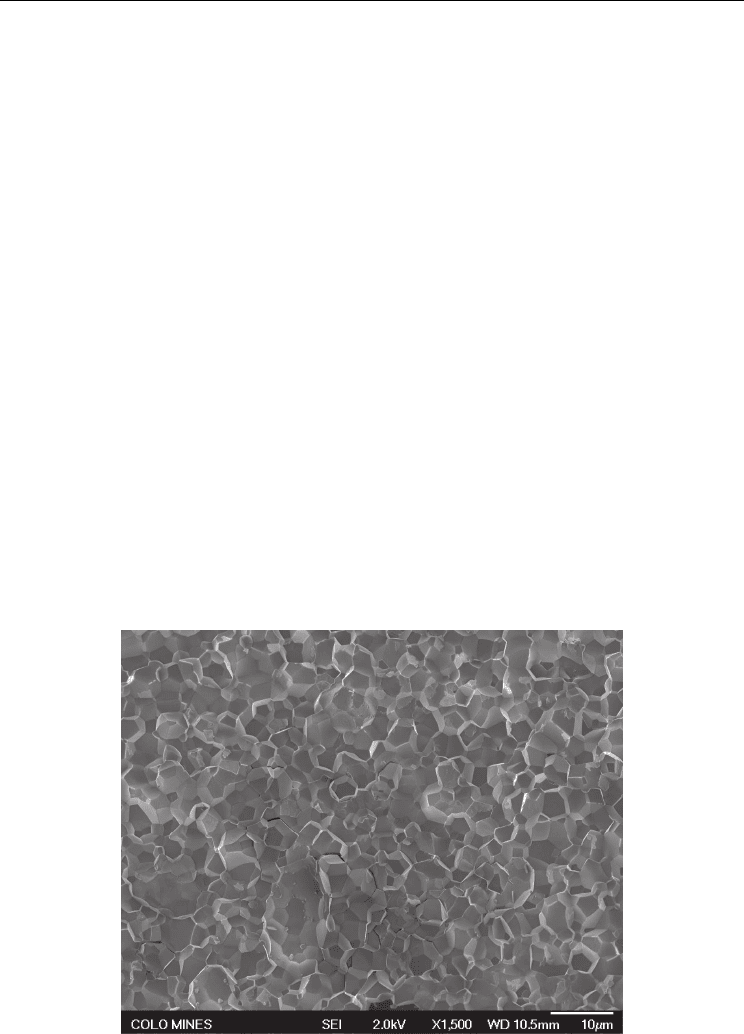
Co-Ionic Conduction in Protonic Ceramics of the
Solid Solution,BaCe
(x)
Zr
(y-x)
Y
(1-y)
O
3-
Part I: Fabrication and Microstructure
493
reactive sintering involves the coordination of liquid phase sintering for grain boundary
formation and ion exchange for bulk BCZY phase formation.
5.4 Microstructure after reduction
Conductivity testing of BCZY requires extended operation in moist and dry hydrogen at
elevated temperatures. Post-reduction microstructure analysis was conducted to determine
if the residual NiO causes any deleterious effects. Figure 10 shows a FESEM fracture surface
of BCZY26 after multiple temperature cycles between 200 and 1000 ºC in moist and dry 5%
H
2
/bal Argon. It may be observed in the image that nearly all of the fracture has occurred at
grain boundaries, unlike the as-fired ceramic that exhibited mostly transgranular fracture.
This suggests a weakening of the structure at grain boundaries due to a combination of
reducing atmosphere and strain from temperature excursions. Also visible in the
micrograph is a network of microcracks. The ceramic specimens typically failed
catastrophically upon decreasing temperature in moist hydrogen or argon at some point
below about 400 ºC. In dry atmosphere, no fracture was observed. We believe the fracture is
due to the strain induced by water of hydration at elevated temperatures that remains
“frozen-in” at low temperatures from stoichiometric expansion. We have demonstrated with
BCY and BZY that lattice hydration causes a measureable length dilation that has actually
been used in TCE measurements to determine the extent of hydration (Coors & Swartzlander,
2005). Apparently, in the case of reactive sintered BCZY, the stress exceeds the strength of the
material. This obviously is a matter of concern that will require careful management of
operating parameters. Recently, preliminary investigations have indicated that much stronger
and durable ceramic results when BaSO
4
is substituted for BaCO
3
. In this case the sintering
temperature is higher (~1600 ºC) because of the higher decomposition temperature of the
sulfate, but distinctly improved grain boundaries are obtained. Also, reduction of the yttrium
dopant concentration from 20 to 10 mol% seems to improve the mechanical properties without
Fig. 10. FESEM Micrograph reduced BCZY26 fracture surface (1500x).
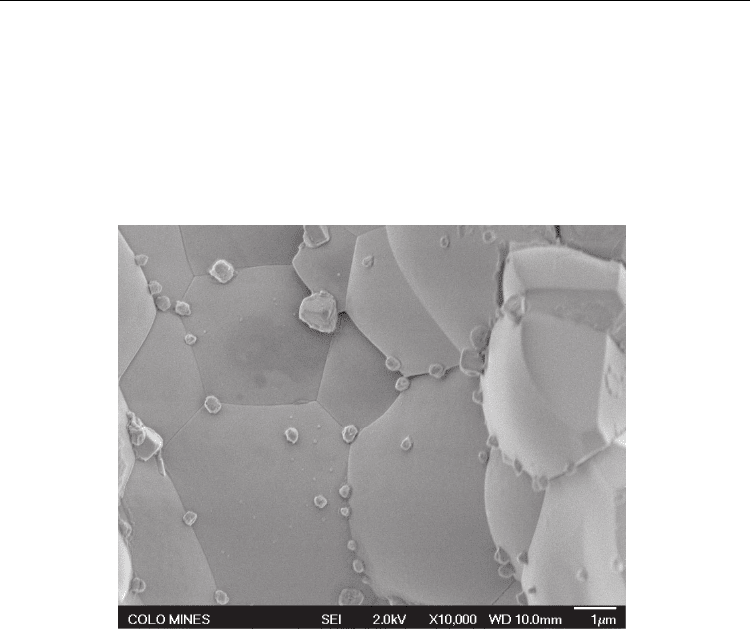
Advances in Ceramics - Synthesis and Characterization, Processing and Specific Applications
494
much sacrifice in conductivity, even though the oxygen vacancy concentration is one half as
much. The formulation that seems to provide the best compromise of chemical stability,
mechanical strength and proton conductivity is 1NiBCZY27.
Figure 11 is an enlarged view of a residual pore in 1NiBCZY26 after reduction. In this case,
the surfaces of the grains are as-fired. The fracture is clearly visible along some grain
boundaries. The most interesting feature of the micrograph is the presence of
nanoprecipitates occurring predominantly along grain boundaries. Figure 12 is an EDS scan
of one of these compared to the bulk grain. The precipitates were found to be mostly nickel.
Fig. 11. FESEM Micrograph reduced BCZY26 surface of internal void with metallic Ni
precipitates (10000x).
The specimen was subsequently analyzed for magnetic properties to determine the nature of
the nickel precipitates using a Quantum Design PPMS. Figure 13 (top) shows the magnetic
moment versus temperature. The sharp drop at 620K, the Currie temperature for bulk
nickel, is the signature for metallic nickel. In Figure 13 (bottom), the magnetic moment
versus field strength, H, is shown. The black curve is for a piece of nickel wire calibrated to
the same nickel mass as in the 1NiBCZY26 specimen. The red curve is for the fully reduced
BCZY26 specimen. It may be seen that the magnetic saturation is characteristic of
ferromagnetic bulk metallic nickel. Also, the shallow slope of the magnetization curve at
low field is characteristic of small, isolated nickel particles, which is consistent with the
small precipitates in Figure 11. Even at 1000 Gauss, the magnetization has reached less than
half its saturation value, in sharp contrast to the curve for the bulk nickel wire, which was
almost fully saturated at this same field. It was possible to determine quantitatively from the
saturated magnetization at 5000 Gauss that the wt% of metallic nickel in the specimen was
0.854%. A subsequent measurement using a QD-SQUID gave a value of 0.882%. The actual
value for the 1NiBCZY26 specimen determined by X-ray Fluorescence was 0.825%. Within
experimental error, virtually 100% of the original NiO has been reduced to bulk Ni metal. It
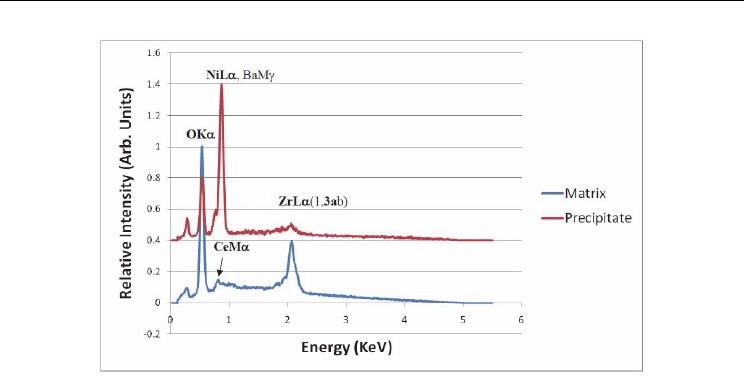
Co-Ionic Conduction in Protonic Ceramics of the
Solid Solution,BaCe
(x)
Zr
(y-x)
Y
(1-y)
O
3-
Part I: Fabrication and Microstructure
495
Fig. 12. EDS acquired using an electron beam with 5 KeV of energy. Ce and Ba have weak M
band excitations (strong L bands for both occur at ~4 KeV). Nickel present predominantly in
the nanoprecipitate.
is possible to draw two important conclusions from this finding: 1) very little, if any, nickel
was lost during sintering and subsequent elevated temperature operation, and 2) a
negligible fraction of the original nickel remains in the ceramic as ions. Although it is not
possible to rule out that some Ni nanoprecipitates may exist within grains, as was found to
be the case with Ni-reactive sintered yttria-stabilized zirconia (Coors, et al. 2009). The SEM
image in Figure 11 suggest that most occur at grain boundaries. In any event, the possibility
of nickel residing intersticially or substitutionally on regular lattice sites as ions may be
considered remote.
XRD patterns were obtained on 1NiBCZY26 after reduction. The as-fired and post reduction
patterns are shown in Fig. 14. There was no change in lattice parameter, and the strongest
metallic nickel line (111) at 44.5º is just barely visible. The lower figure expands the region
from 28º to 33º in which the four strongest peaks of the phase, BaY
2
NiO
5
(00-041-0463) occur.
These peaks are clearly visible in the as-fired ceramic, but have completely disappeared in
the reduced specimen. The phase was identified as a grain boundary phase left over from
SSRS (Tong, et al. 2010). With some of the barium tied up in this grain boundary phase, it is
expected that the as-fired perovskite is slightly A-site deficient, but upon reduction, metallic
nickel nanoprecipitates form, and the barium and yttrium are apparently dissolved back
into the perovskite lattice. For most commercial applications envisioned with these protonic
ceramics, reducing atmosphere is anticipated. This will certainly be the case for hydrogen
separation and membrane reactors. In the case of PCFCs, the ceramic will be exposed to
reducing atmosphere on one side and oxidizing on the other. For steam permeable
membranes, SPMs, intermediate oxygen partial pressures may be encountered which are
not low enough to reduce the barium-yttrium nickelate phase. It has yet to be determined if
the reduction of this grain boundary phase is reversible or to what extent proton transport
across grain boundaries may be influenced by this phenomenon.

Advances in Ceramics - Synthesis and Characterization, Processing and Specific Applications
496
0
5
10
15
300 400 500 600 700
Temp (K)
Moment (emu/g-Ni)
BCZY 40mg; 0.34 mg Ni
bulk Ni Tc = 620 K
H = 100 Oe
0
10
20
30
40
50
60
0 2000 4000 6000 8000 10000
Field (Oe)
Moment (emu/g-Ni)
Ni wire standard 1.1mg
BCZY 40mg; 0.34 mg Ni
T = 310
Fig. 13. Reduced NiRS-BCZY26 (top) magnetic moment vs. temperature at fixed field 100 Oe
and (bottom) vs. field at fixed temperature (310 K) by QD-PPMS.
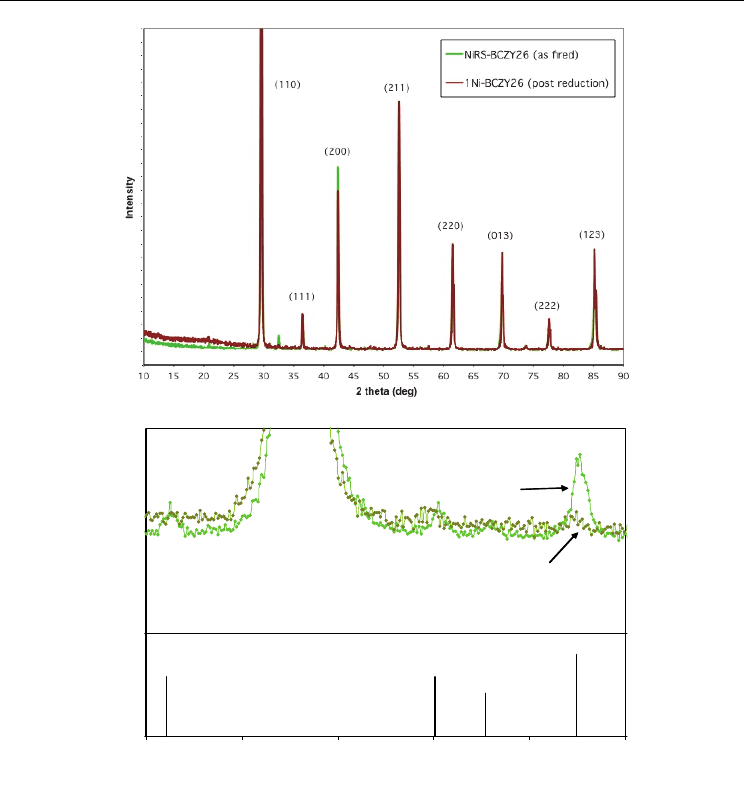
Co-Ionic Conduction in Protonic Ceramics of the
Solid Solution,BaCe
(x)
Zr
(y-x)
Y
(1-y)
O
3-
Part I: Fabrication and Microstructure
497
-25
-5
15
35
28 29 30 31 32 33
2 theta (deg)
Intensity
NiRS-BCZY26
(unreduced)
NiRS-BCZY
(reduced)
(112)
BaY2NiO5 (00-041-0463)
(004)
(020)
(013)
Fig. 14. NiRS-BCZY26 XRD as-fired (light green) and after reduction (dark green) Top figure
10-90º 2
and lower pattern 28-33º with four strongest peaks of BaY
2
NiO
5
(00-041-0463)
pattern.
6. Conclusions
Several compositions of the solid solution BaCe
x
Zr
0.8-x
Y
0.2
O
3-d
(0≤x≤0.8) were prepared by
solid state reactive sintering SSRS using 1 wt% NiO as a sintering additive. Dense, phase-
pure ceramics were obtained with NiO while practically no solid-state reaction or sintering
took place without NiO. It was found that a complete solid solution existed over the entire
composition range, and it was observed that a linear relationship existed between the
pseudocubic lattice constant and the ratio of ceria to ceria plus zirconia on B-sites:

Advances in Ceramics - Synthesis and Characterization, Processing and Specific Applications
498
a(Å)=0.194*[Ce]/([Ce]+[Zr])+4.204). A relatively weaker dependency of lattice constant on
dopant ion was observed. XRD of as-fired ceramics exhibited BaY
2
NiO
5
as the only
identifiable second phase in the, otherwise, phase-pure perovskites. Thought to be a grain
boundary phase, BaY
2
NiO
3
was found to be reduced completely to metallic nickel
precipitates that decorated grain boundaries after extended processing in moist and dry
hydrogen at high temperatures. The mechanical strength of as-fired ceramic was excellent,
while the strength of reduced material was considerably lower – a condition that warrants
caution. Stoichiometric expansion due to frozen in hydration causes ceramic failure at low
temperatures. However, substitution of BaSO
4
for BaCO
3
in the starting powders and
reduction of yttria dopant concentration seem to hold promise as a solution to this problem.
Further evaluation the grain boundary integrity is necessary as these materials are being
considered for practical applications. It may be necessary to add other components to
compensate for loss of strength at grain boundaries. NiO solid state reactive sintering was
demonstrated to be a remarkably easy and inexpensive way to fabricate this potentially
important class of protonic perovskites.
7. Acknowledgments
Special thanks Sophie Menzer and Anthony Manerbino at CoorsTek, Inc. for fabricating and
evaluating specimens. Thanks to Josh White for providing FESEMs and to Prof. Brian
Gorman at the Colorado School of Mines for FIB specimen preparation and HRTEM, and to
Jim O’Brien at Quantum Design, San Diego, CA for providing quantitative magnetometry
analysis on reduced specimens.
8. References
Azimova, M. & McIntosh, S. (2009). Transport properties and stability of cobalt doped
proton conducting oxides. Solid State Ionics, Vol.180[2-3], pp.160-167
Babilo, P. & Haile, S.M. (2005). Enhanced sintering of yttrium-doped barium zirconate by
addition of ZnO.
J. Am. Ceram. Soc., Vol.88, No.9, pp.2362-2368
Coors W.G. & Swartzlander, R. (2005). Partial conductivity measurements in BaCe
0.9
Y
0.1
O
3-d
by impedance spectroscopy.
Proceedings of the 26
th
Risø International Symposium on
Materials Science: Solid State Electrochemistry
, Linderoth, et al., Eds., September 4-8,
pp.185-196
Coors, W.G.; Zhao, F.; Heck, B. (April 2008). Reaction sintered BCY10 ceramic – Fabrication
and microstructure,” Internal CoorsTek Report (available from author upon
request)
Coors, W.G. (Sept 2008). Reaction sintered BZY10 ceramic - Fabrication and microstructure,
Internal CoorsTek Report, (available from author upon request)
Coors, W.G.; O’Brien, J.; & White, J. (2009). Conductivity degradation of NiO-containing
8YSZ and 10YSZ electrolyte during reduction.
Solid State Ionics, Vol.180, pp.246-251
Costa, R.; Grünbaum, N.; Berger, M.-H.; Dessemond, L.; Thorel, A. (2009). On the use of NiO
as sintering additive for BaCe
0.9
Y
0.1
O
3-a
. Solid State Ionics, Vol.180, pp.891-895
Galasso, F.S. (1969) Structure, Properties and Preparation of Perovskite-type Compounds,
Pergamon Press, Ltd.,
